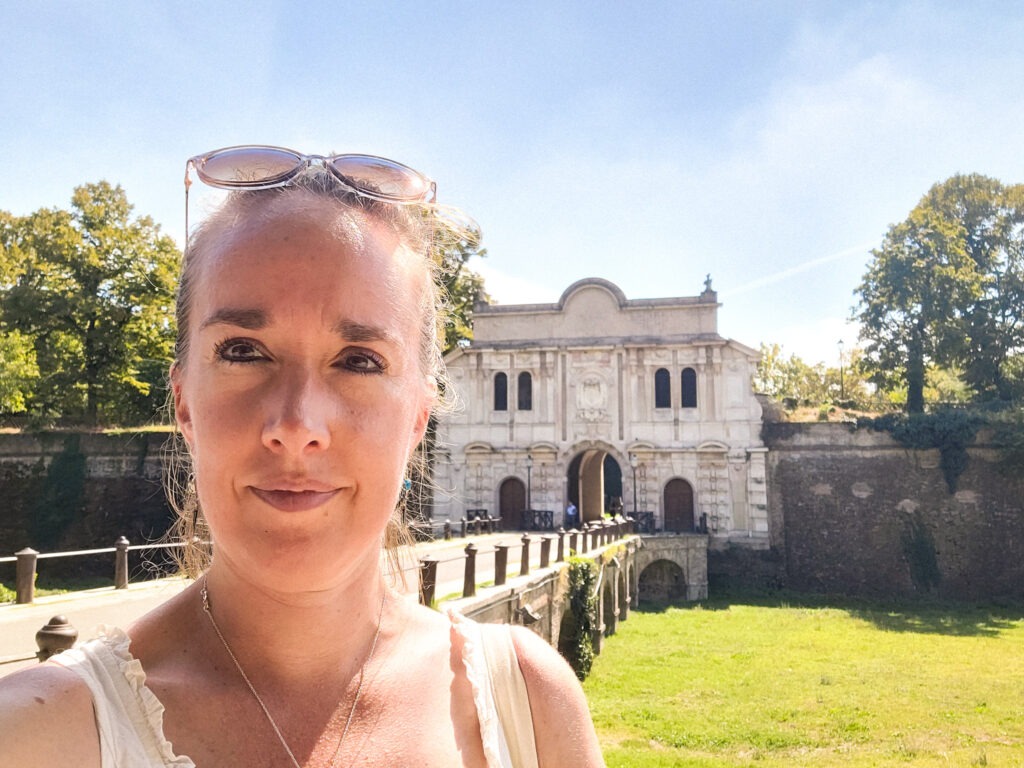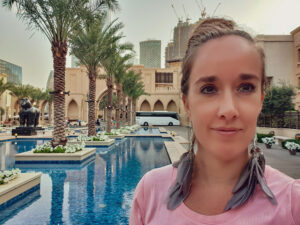Parma is located in the Emilia Romagna region of Italy. The city is undoubtedly a hidden gem that is often overlooked by tourists. Boasting a rich cultural and historical heritage, the city is a paradise for those who like to explore the past. The city is famous for its gastronomy, particularly Parma ham and Parmigiano Reggiano cheese. But there is so much more to discover here. From its stunning monuments, artistic masterpieces to its charming streets, there is something to suit everyone. In this article I tell you about the monumental highlights to visit in Parma.
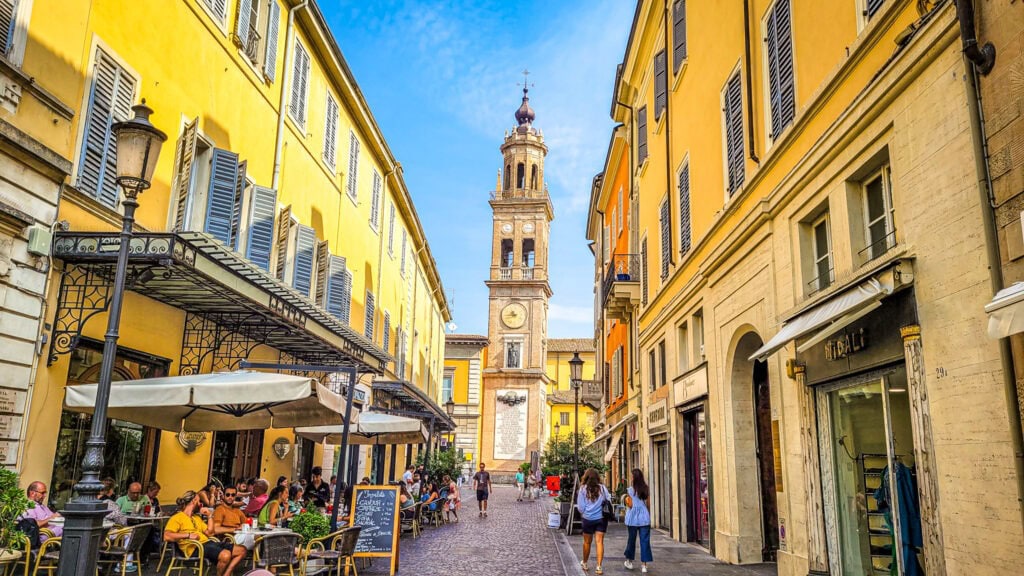
Table of Contents
Basilica di Santa Maria della Steccata
The history of the Basilica di Santa Maria della Steccata dates back to the 16th century. The Duke of Parma, Ottavio Farnese, commissioned the construction of a new church in honour of the Virgin Mary. The church was built on the site of an existing chapel, and construction began in 1521. Due to several interruptions, including the invasion of Parma by troops of the Holy Roman Empire, the church was not completed until 1633. It was consecrated in 1635 by Monsignor Pietro Vidoni, Bishop of Parma.
The name “Steccata” comes from the Italian word “steccato”, meaning “fence”. It refers to the wrought-iron fence that encloses the portico in front of the church. The fence was designed to protect the faithful from the horses and carriages that once passed by.
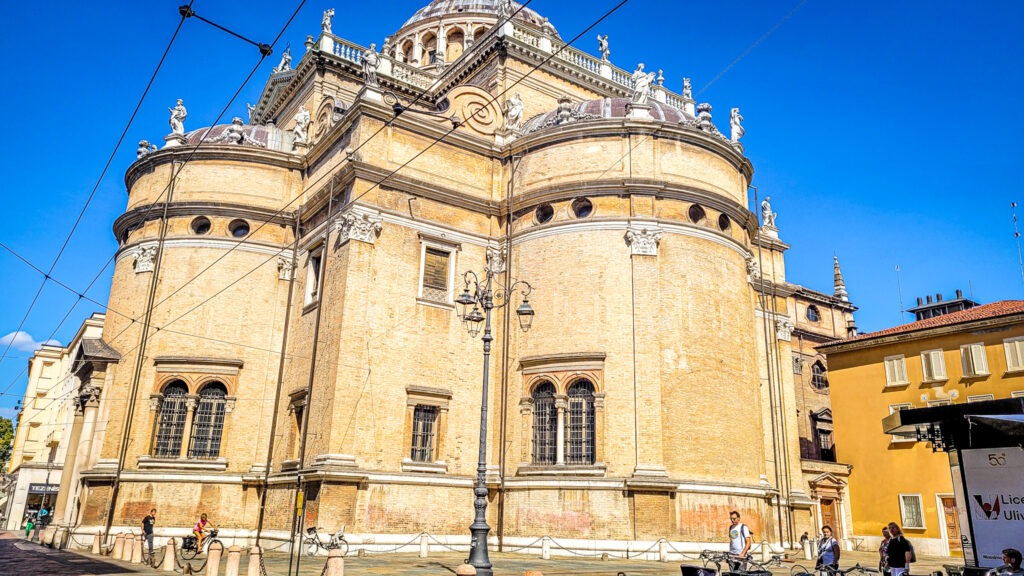
Baroque architecture
The Basilica di Santa Maria della Steccata is a stunning example of baroque architecture, with its soaring dome, ornate façade, and opulent interior. The design of the church was influenced by the works of the great Italian renaissance architects, including Raphael, Michelangelo, and Bramante.
The façade of the church is decorated with elaborate carvings and sculptures, including a depiction of the Virgin Mary holding the infant Jesus, surrounded by angels and cherubs. The interior of the church is equally impressive, with its marble floors, frescoes, and altars. One of the main features of the interior is the majestic dome, which is embellished with intricate paintings and stucco work.
The walls of the church are adorned with beautiful frescoes, including those by the Fianese brothers, and there are numerous chapels containing intricate sculptures, altars, and paintings. The crypt, located under the main altar, contains the remains of many of the Duke of Parma’s family members.
Palazzo del Governatore
Palazzo del Governatore in Parma has served many purposes throughout its history. From a residence for the Governor of Parma, it was later converted into an exhibition space. Today it is an important cultural and artistic centre that hosts various events and exhibitions. The palace is one of the most remarkable neoclassical buildings in the city. With its broad pediment and majestic entrance, adorned with massive columns. Its façade is very attractive, with a rectangular shape, traditional white colour and subtle marble decorations.
Entering Palazzo del Governatore, one cannot help but feel awed by its grandeur and elegance. The palace is divided into two floors, each with a specific function. The lower level is dedicated to the palace’s historical archives and the art gallery. The upper level is reserved for official receptions, ceremonies and concerts. The impressive staircase is leading to the upper floors with high ceilings, and marble decorations.
A tour of Palazzo del Governatore in Parma would not be complete without visiting the museum’s Gallery of Modern and Contemporary Art. The exhibition rooms, designed in a modern and minimalistic style, host various exhibitions, from archaeological finds to contemporary art displays. Moreover, the palace often selects temporary exhibitions throughout the year to keep the visitors interested with different narratives.
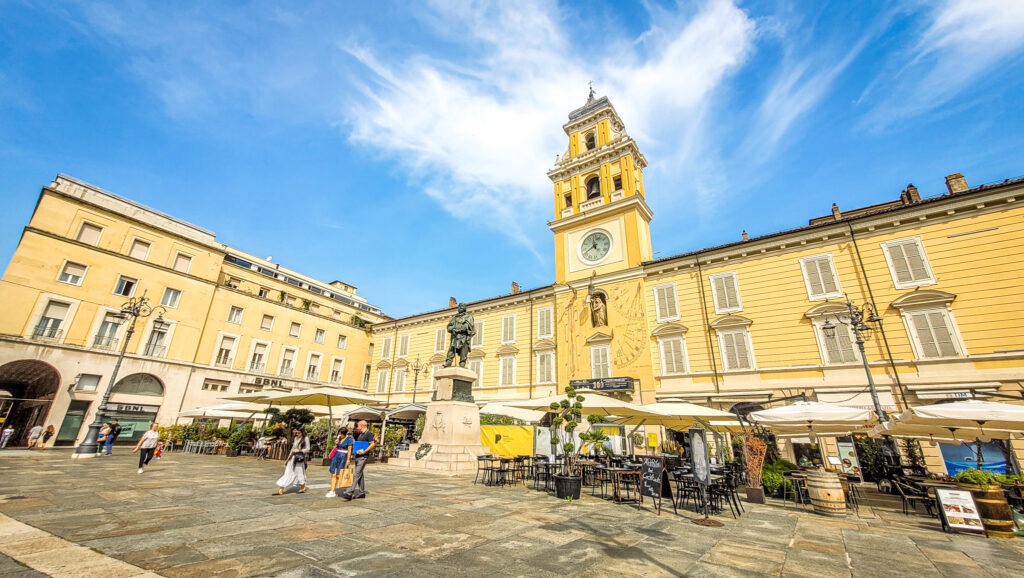
Palazzo del Podesta
Palazzo del Podesta was built between 1218 and 1240 AD and was originally known as “Palazzo del Capitano del Popolo”. It was built in the Romanesque style and was the residence of the Capitano del Popolo. He was the chief magistrate of the city. During the 14th century, the palace was expanded and renovated under the rule of the Visconti family. They wanted to transform the building into a symbol of their power. In 1804, the palace was renamed Palazzo del Podesta. Since than it is the headquarters of the Provincial Administration of Parma. Today, the palace is open to the public and a popular tourist attraction.
When you visit Palazzo del Podesta, make sure to check out some of its most remarkable features. One of them is the Sala della Costituzione, which was decorated by the artist Parmigianino in the 16th century. The room features a fresco depicting Moses receiving the tablets of the Ten Commandments. It is regarded as one of the finest Renaissance-era frescoes in Italy. Another highlight of the palace is the Sala del Giudizio, which has a beautiful wooden ceiling with intricate carvings and paintings. The room was once used as a courtroom and is now used for official events.
Architectural style of Palazzo del Podesta
Palazzo del Podesta is a blend of various architectural styles. It was built in the Romanesque style, but over the years, it has undergone numerous renovations and expansions, resulting in a mix of gothic, renaissance, and baroque elements. One of the most striking features of the palace is its facade, which is adorned with beautiful sculptures and reliefs depicting various historical and mythological figures. The interior of the palace is equally impressive, with stunning frescoes, murals, and tapestries decorating the walls and ceilings.
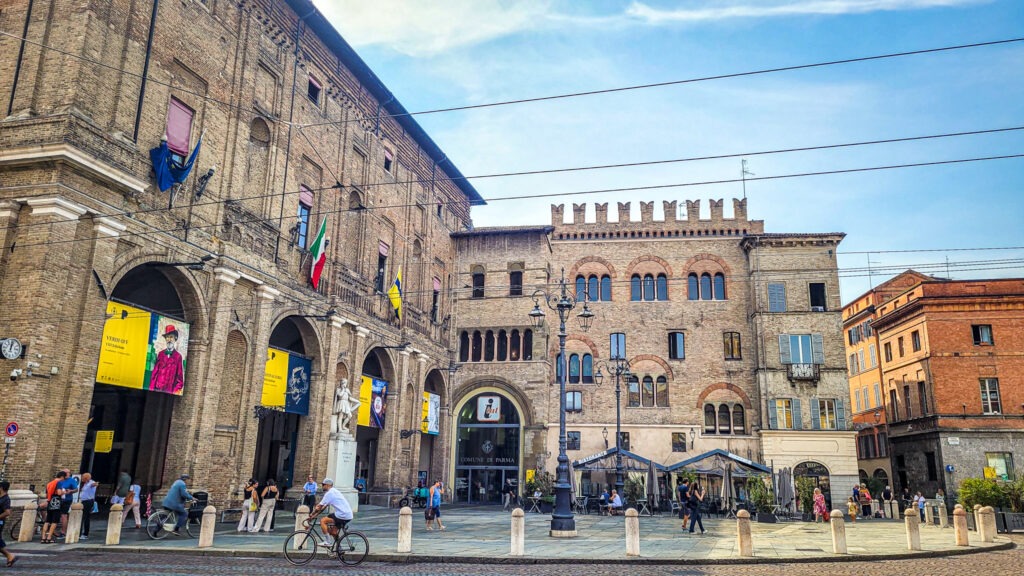
Baptistery of Parma
The Baptistery of Parma is the oldest, religious buildings in this fabulous Italian city. The construction of this landmark dates back to the 12th and 13th centuries, and it took just under a century to complete. The Baptistery was designed as a domed octagonal building and consists of a lower and an upper octagon. The upper section is host to an awe-inspiring collection of frescoes, which were painted by famous artists such as Antonio da Correggio and Benedetto Antelami. Considering the ambitious building project, it’s easy to see why the Baptistery is viewed as one of the most magnificent masterpieces of medieval architecture.
The Baptistery of Parma has a very distinct architectural style, and it is particularly admired for its beautiful Romanesque and Gothic influences. The building captures the imagination of visitors with its stunning designs, intricate detailing, and beautiful colours. It’s a must-visit place for any architecture enthusiast or lover of Italy’s art and history. The pairing of vibrant shades of colours like subtle blues, greens, and earthy reds is particularly noticed in the geometric shapes, arches, and decorative shapes, giving the Baptistery is distinctive design.
Gates of Paradise
One of the Baptistery’s unique features is its bronze south door, which is widely referred to as the Gates of Paradise. This door depicts the scenes from the Old and New Testaments with a level of intricacy and detail that is beyond words. This masterpiece was completed by Lorenzo Ghiberti and took over 25 years to build. The door which was installed in the building in 1460 is considered as one of the most significant creations of all time.
The Baptistery is filled with interesting historical artefacts that are sure to fascinate any culture enthusiast. Some of these historical artefacts include bambino, a beautiful statue of the Infant Jesus, Benedetto Antelami’s sculptures, and the Baptistery’s baptismal font. The font is believed to date back to the 12th century.
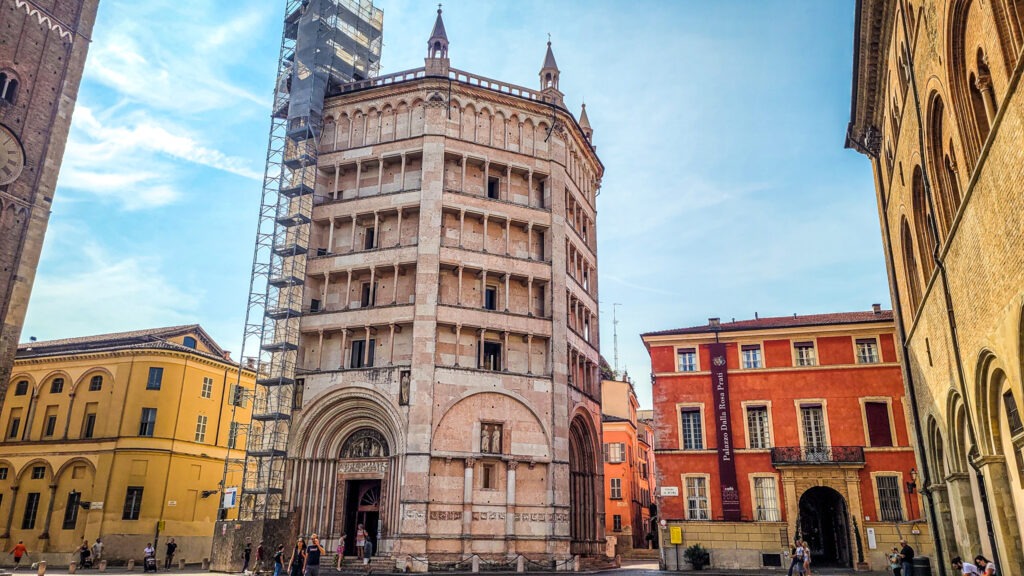
Parma Cathedral
The Cathedral of Parma is an important landmark of Emilia Romagna, Italy. The structure was first built in the sixth century, as a Romanesque building. Following its destruction in an earthquake in 1117, it was rebuilt. In 1206, a new foundation was laid. The Cathedral has undergone several transformations throughout the years. It wasn’t until 1616 that the project was completed, which took over four centuries. Given its age, it’s no surprise that the Cathedral is full of vibrant stories, making it one of the best monumental highlights to visit in Parma.
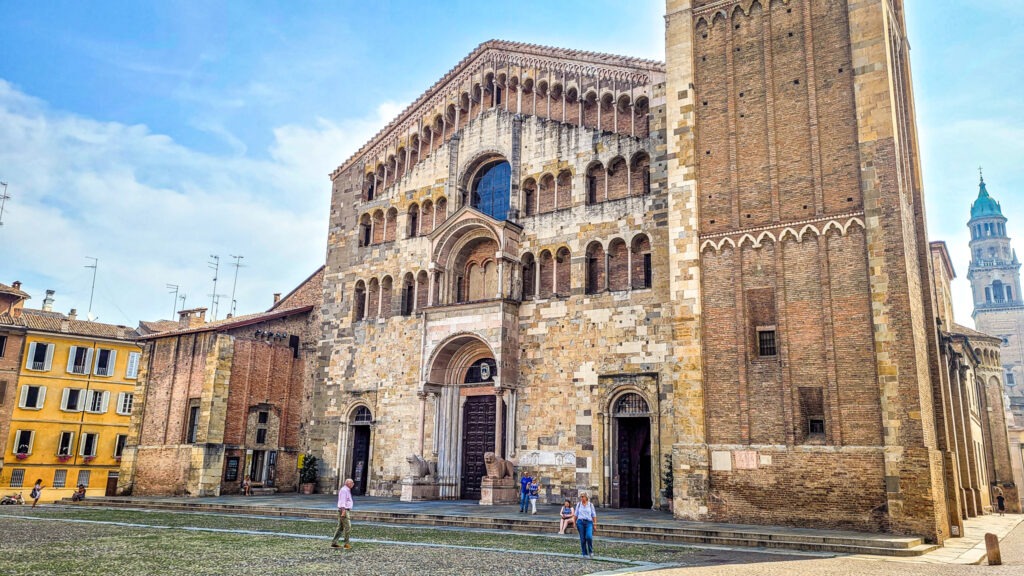
Architecture of Parma Cathedral
The Cathedral’s design is a mix of various architectural styles, from the Romanesque and the Gothic to the Renaissance. The building’s facade stands out with striking details, including exquisite sculptures that depict stories from the Bible and various religious figures. The Cathedral’s interior is equally breathtaking. The cathedral has richly decorated chapels, a superb painting by Correggio, and a grand altar that features a beautifully carved wooden sculpture.
Works of Art
The artistry at Parma Cathedral goes beyond its architecture. The cathedral houses a variety of artworks that date back to the thirteenth century, a true testament to the centuries-long cultural influence of the place. The most famous art piece in the Cathedral is The Assumption of the Virgin, a painting by Correggio. The painting is a masterpiece of the high Renaissance period and an excellent representation of classical ideals. Other significant works include The Nativity of Virgil Raineri, The St. John the Baptist in Glory by Guercino, among others.
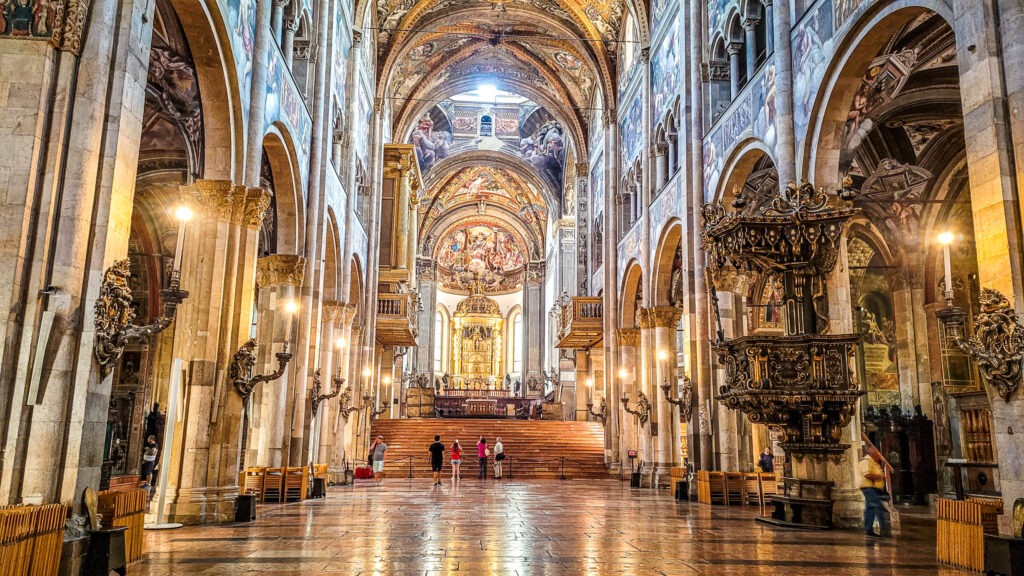


Chiesa di San Giovanni Evangelista
The history of the Chiesa di San Giovanni Evangelista dates back to the 10th century. The church was initially built as a Benedictine monastery, but it has undergone several transformations over the years. The current structure of the church was completed in the 13th century. During the 16th century, the church was renovated and decorated with frescoes by the renowned Italian painter, Parmigianino.
The architectural style of the Chiesa di San Giovanni Evangelista is a unique blend of Gothic and Romanesque styles. The façade of the church, which was built in the 13th century, displays typical Romanesque features such as the columns, round arches, and decorative motif. The Gothic style of the church is particularly evident in the asymmetrical tower. The tower is a rare example of a Gothic structure in this region.
The interior of the Chiesa di San Giovanni Evangelista is decorated with intricate frescoes, sculptures, and decorative motifs. The frescoes were painted by Parmigianino and depict religious scenes that are still vivid despite being over 400 years old. Another notable feature is the stunning marble pulpit, which is one of the most beautiful pulpits in Italy. The pulpit is adorned with intricate carvings and sculptures that depict scenes from the Bible.
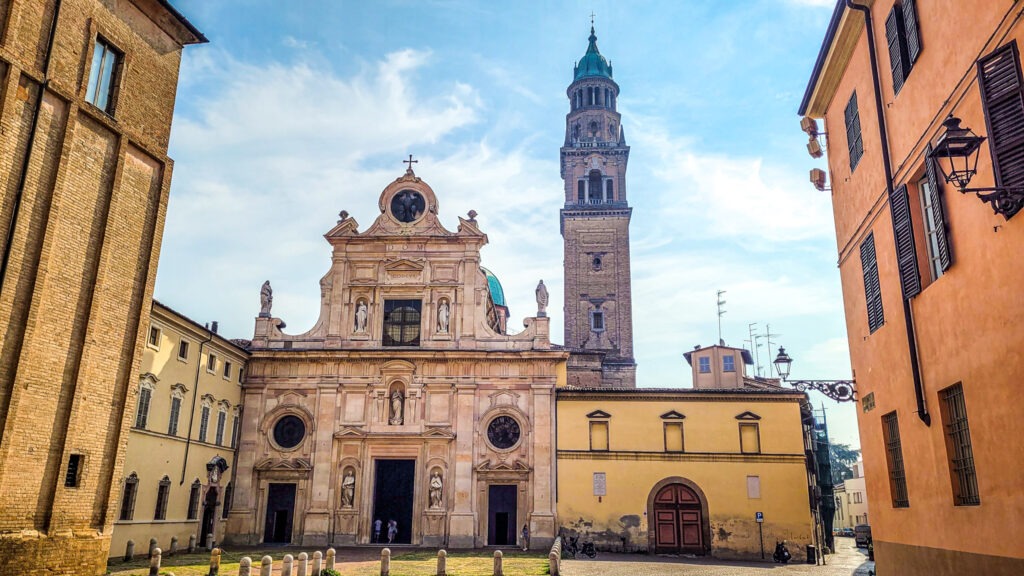
Camera di San Paolo e Cella di Santa Caterina
The Camera di San Paolo was once an anchorite’s cell and is located on the right-hand side of the left nave inside the church of San Giovanni Evangelista. The building’s architecture exhibits a 14th-century Renaissance style. The floored room was initially designed to accommodate the solitary lifestyle of a hermit. The walls of the room showcase an intricate display of 14th-century frescoes designed by artists like Jacopo Loschi and Pietro da Rimini. The frescoes depict several themes but are mainly focused on the life of Christ and the story of St. John the Evangelist. A visit to Camera di San Paolo provides a rare glimpse into the life and culture of medieval times.
The Cella di Santa Caterina, located in the premises of the nearby church of Santa Maria della Steccata, was initially built for the Dominican Sisters during the 16th century. The structure’s architecture exhibits a luxurious and lavish style showcasing the cultural influence of the 16th century Renaissance period. The building’s facade is adorned with magnificent bas-reliefs, while the internal space showcases a unique fusion of geometric and floral designs that further highlight the building’s opulence. A beautiful fresco, the representation of the Apocalyptic Vision, by Michelangelo Anselmi, covers the entire ceiling of the vault.
Piazza della Pace
The Piazza della Pace is located in Parma’s historic centre and is surrounded by some of the most popular cultural landmarks of the city. The square, which was built in the 16th century, is known for its beautiful layout and serene atmosphere. It reflects a mix of architectural styles that were popular during the Renaissance period, including Gothic, Baroque, and Neoclassical.
The central fountain, which dates back to the 17th century, is the main attraction of the Piazza della Pace. It was designed by Ferdinando Tacca, one of the most famous sculptors in Italy. It features the statue of a boy holding a fish in his hand. The fountain is surrounded by benches and provides a great spot for visitors to rest and take in the beauty of the piazza.
The San Francesco del Prato church is another popular landmark located on the Piazza della Pace. It was built in the 13th century and underwent several renovations over the years. The church’s architecture is a mix of Gothic and Renaissance styles, making it a unique example of the city’s architectural history. The interior of the church is decorated with beautiful frescoes and sculptures that represent the region’s culture and traditions.
Another notable feature of the Piazza della Pace is the Palazzo della Pilotta, a stunning palace that houses several museums and art galleries. The palace was built in the 16th century and features a Baroque-style architecture, making it a popular destination for visitors interested in art and history.
The Teatro Farnese, which is located inside the Palazzo della Pilotta, is another must-visit attraction in the Piazza della Pace. The theatre is one of the oldest wooden theatres in the world and features a grand design that portrays the opulence of the Renaissance period.
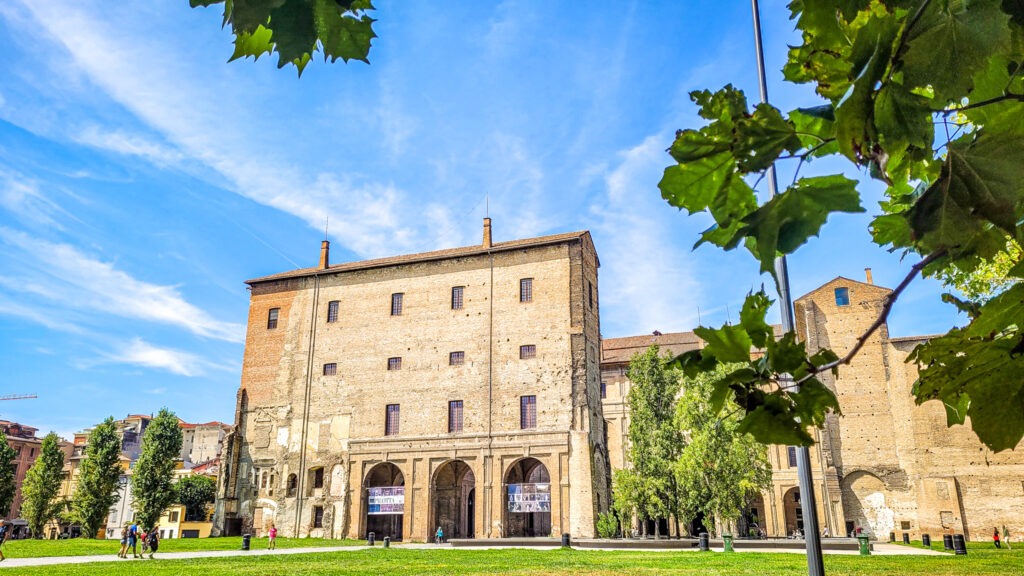
Monumento a Giuseppe Verdi
The Monumento a Giuseppe Verdi is located on the Piazza della Pace. It’s in front of the Teatro Regio, the famous opera house. The monument was inaugurated in 1906, two years after Verdi’s death. It was created by two sculptors, Enrico Barbieri and V. Vela, and built entirely in white marble. The monument depicts four female allegories representing the famous compositions by Verdi; Don Carlos, Aida, Otello, and Falstaff. Each allegory represents an emotion that the specific opera evokes.
The architecture of the monument has a unique style that echoes the influences of Art Nouveau and Neo-classical architecture. The monument’s base is a pedestal with a square base which has alternate eights and sixteens curved on its four sides. It is a classic example of Art Nouveau, with supremely decorated sculptures on every side of the square. The ornate sculptural friezes of women, cherubs, and musical instruments are inspired by ancient columns.
Visitors and architecture enthusiasts would appreciate the intricate details of Monumento a Giuseppe Verdi in Parma. The structure has undergone several renovations over the years. The last change occurred in 2009 when some restoration work was done to the monument, attempting to take it back to its original charm and appeal.
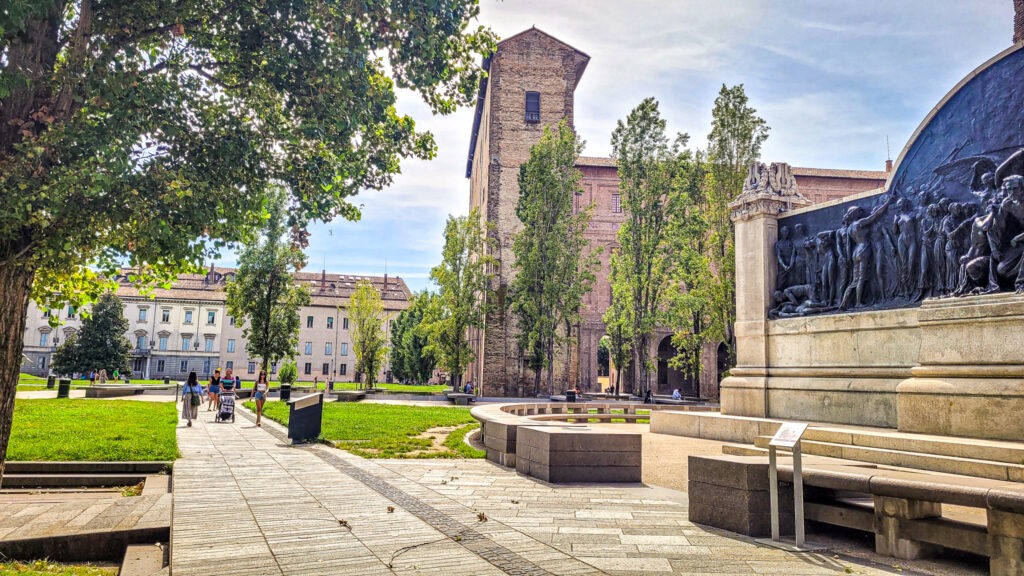
Palazzo della Pilotta
The Palazzo della Pilotta has a rich history that spans over 400 years. The Farnese family commissioned the palace in the mid-16th century to serve as their main residence. Later, it became the seat of the Duchy of Parma and Piacenza. Over the years, the palace underwent several modifications and additions, including the construction of the Teatro Farnese, which is now one of the most significant attractions in the palace. During World War II, the palace was damaged, but extensive restoration work has been carried out since then, making it the magnificent structure it is today.
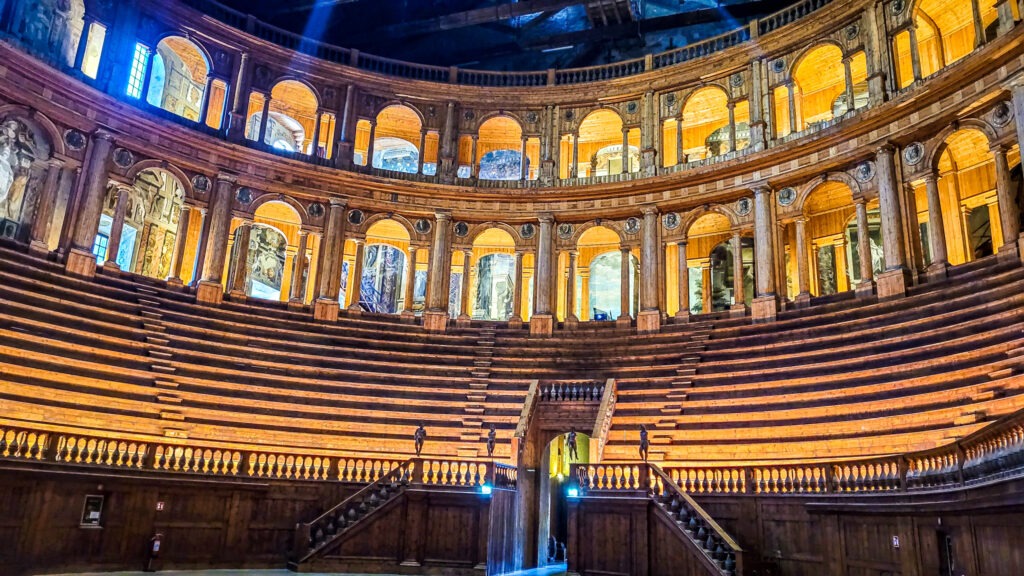
Architecture
The architecture of the Palazzo della Pilotta is breathtaking, with each part of the palace designed to serve a unique purpose. The palace’s façade is a beautiful example of Baroque architecture, with intricate carvings and ornate reliefs depicting scenes from Greek mythology. The palace’s interior also follows a Baroque style and houses several galleries, salons, and halls, each decorated with impressive frescoes and paintings. Visitors should also explore the Teatro Farnese, which is one of the oldest auditoriums in the world and one of the most important examples of Baroque theatre architecture.
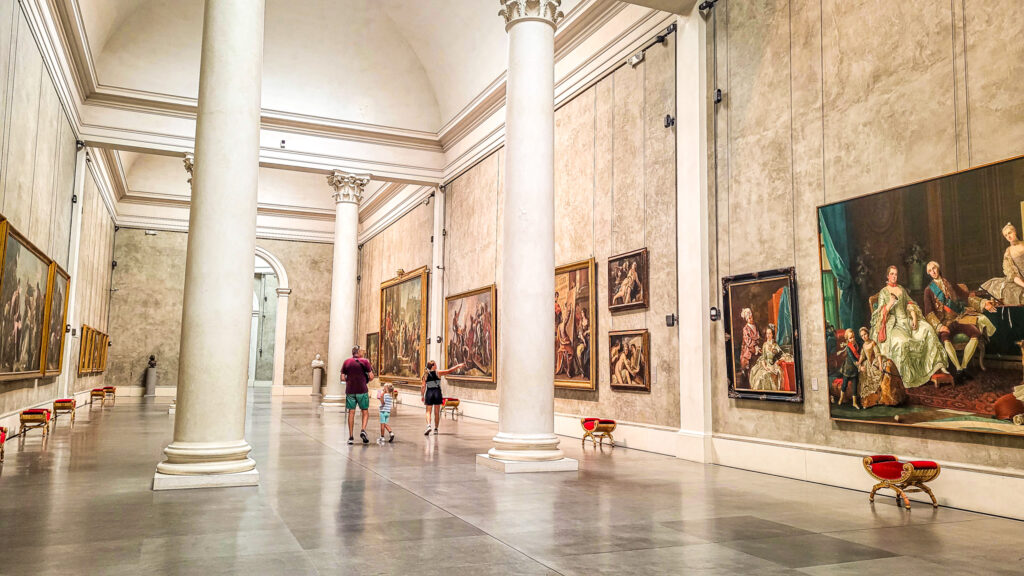
Culture
Palazzo della Pilotta is steeped in culture and heritage, making it an essential destination for art and history enthusiasts. The palace’s National Gallery houses an extensive collection of artworks that span from the medieval period to modern times. The Archaeological Museum, on the other hand, features artifacts dating as far back as the Bronze Age. The Museum of Bodoni is home to one of Europe’s most significant collections of 18th-century printing equipment. The library at Palazzo della Pilotta is also a remarkable treasure, housing over 700,000 volumes, including rare manuscripts and incunabula.



Parco Ducale
The Farnese family commissioned the creation of Parco Ducale in the 16th century to create a grand entrance into their palace. It was designed by French architect Jean Baptiste Alexandre Leblond and contributed to the overall beauty of the palace complex. Jean Baptiste was a well-known architect of his time and is famous for the magnificent building projects he completed throughout his career. The park was originally used for celebrations, theatrical performances, and parties for the elite before becoming available to everyone in the nearby area.
The architectural style of Parco Ducale features elements of both the Italian and French Renaissance style. The park has a grand fountain, the Fontana del Trianon which was inspired by the fountains in the famous gardens of Versailles. It also features an English garden, which came into vogue as a design idea in the 1800s. The park is rife with themes from antique mythology, with numerous statues and representations of the gods and goddesses. The statues add a unique cultural perspective and an artistic touch to the park.
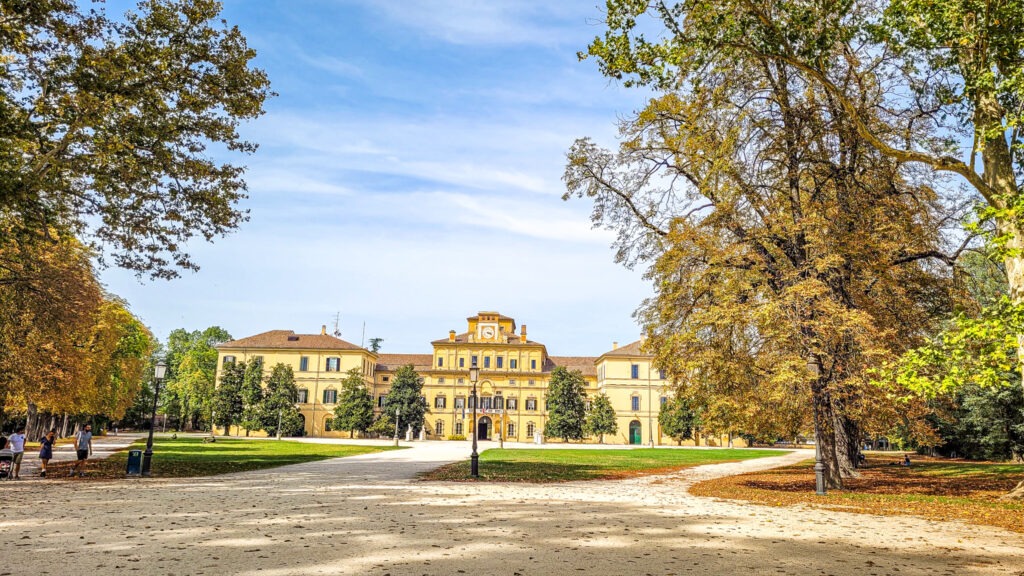
Palazzo Ducale
Perhaps the most famous building situated within the park is the Palazzo Ducale. This impressive structure was originally built as the palace of the Duke of Parma in the 16th century and has since been used for many different purposes, including as a court, a military academy, an art school, and an exhibition centre. The palace is known for its Baroque style, with elaborate facades decorated by elaborate sculptures, dormers, balustrades, and more. The interior provides an excellent example of the Rococo interior style.
The parc has undergone numerous renovations, starting with extensive works in the early eighteenth century. Further additions were done in the 1800s. The restoration of the park by the Italian government has continued over the years. A few additions are the Citrus Garden, the “Green Theater,” and a botanical garden. The restoration of the gardens was completed in the early 1990s. The parc offers a variety of activities such as bird watching, jogging, and cycling amid other popular activities.
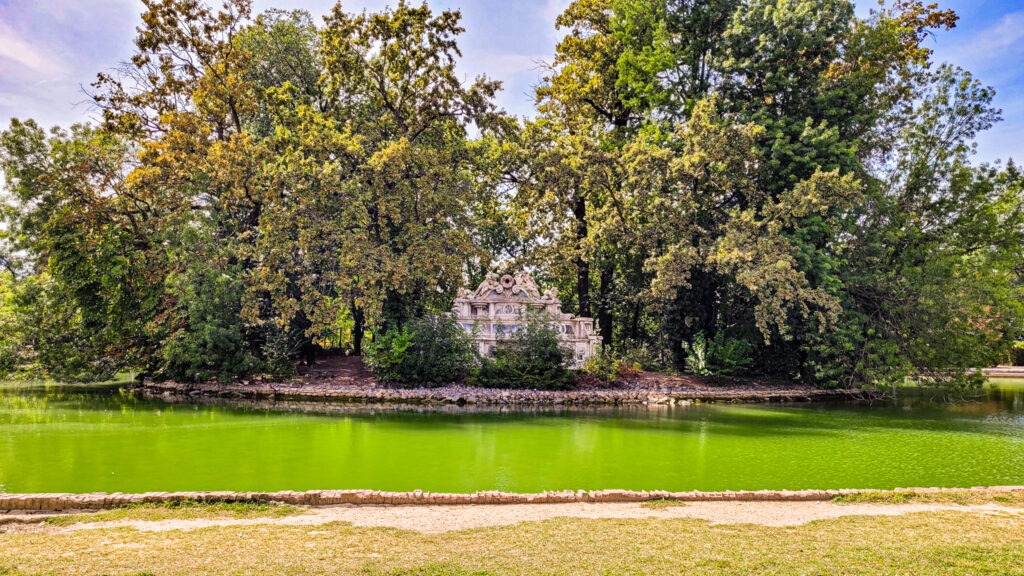
Monumental highlights in Italy
Experience the allure of Italy’s rich historical sites. Explore the best monumental highlights to visit in Bologna. It’s one of Italy’s most underrated cities, no joke! It’s got a crazy long history dating back to the renaissance period, loaded with culture, art, and amazing food. Don’t forget to stop in Modena and get away from the crowds for a few hours. Marvel at the charming houses along the picturesque Italian Riviera coastline at Cinque de Terre. Immerse yourself in the wonders of Florence, the city that nurtured Leonardo Da Vinci’s genius. Take a moment to embrace the enchantment of the Uffizi Gallery, a masterpiece among museums. Exploring Rome presents an incredible chance to delve into the captivating history of the Roman Empire. Don’t miss out on this amazing opportunity when you have some spare time!
